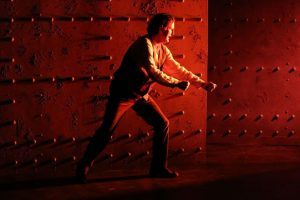
Colin Hamell portrays more than twenty characters in one-man show at the Irish Rep (photo by Carol Rosegg)
Irish Repertory Theatre
W. Scott McLucas Studio Theatre
132 West 22nd St. between Sixth & Seventh Aves.
Tuesday – Sunday February 18, $50
212-727-2737
irishrep.org
Playwright Bernard McMullan takes audiences from the fiery furnaces of hell to the heavens above in the seventy-five-minute one-man show Jimmy Titanic, cruising along at the Irish Rep through February 18. The play was first performed in 2012 in tribute to the centennial of both the birth and death of the RMS Titanic, which sank on April 14-15, 1912, after hitting an iceberg on its maiden voyage. The show is now back with its stalwart captain, Colin Hamell, who has been with it since the beginning, steering it around the world. Hamell serves as narrator/guide as well as playing every character, including Jimmy Boylan, who works on board with his best friend, Tommy Mackey, who helped build the luxury liner at the Harland and Wolff shipyard in Belfast and knows all there is to know about the Titanic. Hamell portrays more than twenty characters in all, from Jimmy and Tommy and other crew members to numerous fictional passengers, the editor of the New York Times, the mayor of Belfast, the real-life John Jacob Astor, Jacques Futrelle, and Senate committee chairman William Alden Smith, and the angel Gabriel, St. Peter, and God. The play works best when Jimmy is on board the “ship of dreams,” relating stories about how it was built, sharing details about its overall impressiveness, and assisting people trying to survive as it begins sinking. Those scenes are chock-full of surprising facts as Hamell floats across Michael Gottlieb’s tight set, a series of riveted metal panels representing the inside of the bottom of the ship, where the men toil in mind-numbing heat. Gottlieb also designed the effective lighting, which changes colors as the tale continues with director Carmel O’Reilly (McMullan’s Return of the Winemaker) at the helm.

Colin Hamell teaches how to shovel coal in Bernard McMullan’s Jimmy Titanic (photo by Carol Rosegg)
The scenes on board the ship are genuinely gripping as Hamell reveals how passengers of different backgrounds, from class to ethnicity to gender, faced peril. Whenever McMullan steers the story back up to heaven, the energy is drained as Hamell portrays Gabriel as a cunning thief, Peter as a selfish lapdog, and God as a gangster. The scenes in the newsroom, the US Senate, and the Belfast mayor’s office offer a look into how the media, politics, and economics dealt with the disaster, but the show drags a bit until it shifts back to the commotion rising on the ship. To those not familiar with many of the facts, it is shocking to learn that there were far more passengers traveling in second and third class than in first, and how there were travelers from more than thirty nations, many seeking a new life in America. “Titanic was primarily an emigrant ship,” Jimmy says, while also talking about the large crew: “Two hundred and forty men worked below in the stokeholds. Only a quarter of them survived. Of the eighty lads working that night on the eight to midnight shift, just twelve made it out.” Jimmy is also proud to point out how most everyone reacted in the midst of the crisis. “The prospect of what lay ahead that night brought out instincts you never knew you had. People were trying to do the right thing. Saving themselves and their loved ones,” he explains. Despite its drawbacks, Jimmy Titanic offers a unique and compelling view of one of the worst tragedies of the twentieth century, focusing on the men behind the scenes.